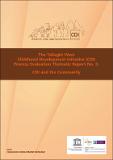The Tallaght West Childhood Development Initiative (CDI) process evaluation Thematic Report No. 5: CDI and the community
Date
2014Author
Canavan, John
coen, Liam
Ozan, Jessica
curtin, chris
Metadata
Show full item recordUsage
This item's downloads: 91 (view details)
Recommended Citation
Canavan, J., Coen, L., Ozan, J. and Curtin, C. (2014) CDI and the Community. Dublin: Childhood Development Initiative.
Published Version
Abstract
BACKGROUND
In 2008, the Child and Family Research Centre (CFRC) was contracted for a three year period by the Tallaght West
Childhood Development Initiative (CDI) to undertake a process evaluation of its work. This report is the fifth in the series
of six thematic reports.
AIMS AND OBJECTIVES
The aim of this evaluation is to examine the role of the community in the work of CDI. Following consultations with CDI,
a number of overarching questions were identified as key to the research:
• Who are the community?
• What was the core logic model regarding how the strategy would be shaped by the local community?
• What structures and processes were established to achieve this?
• What worked well?
• What challenges were encountered?
• How or is the community involved in every aspect of CDI’s work?
• What is the view of the community regarding the work of CDI?
• Does the community feel part of the CDI process?
METHODS AND LIMITATIONS
This report has been undertaken following a multi-method qualitative approach. The following methods were used:
• Literature review establishing the origins of community engagement, examining the rationale behind its use and
presenting a framework for analysing mechanisms of engagement;
• Extensive documentary analysis of a range of CDI documents including strategic documents (e.g. annual reports,
IPA report, Strategic and Communication working groups), newsletters, and evaluation reports. A framework
examining community was generated and agreed with CDI.
• 42 interviews with key informants including CDI team members, Board and Implementation Support Group
members, Consortium members, and staff members from the five services.
The data was organised and analysed in relation to three levels: CDI team and governance structures; CDI commissioned
service providers; and the wider community. The evaluation team also adopted a three-phased approach to examine
community: the development phase; implementation; and the next, post-implementation, phase.
The overarching limitation of this report is the absence of the direct voice of the community – reflecting prior decisions
not to undertake survey work, and practical difficulties in accessing other non-CDI connected community actors.


